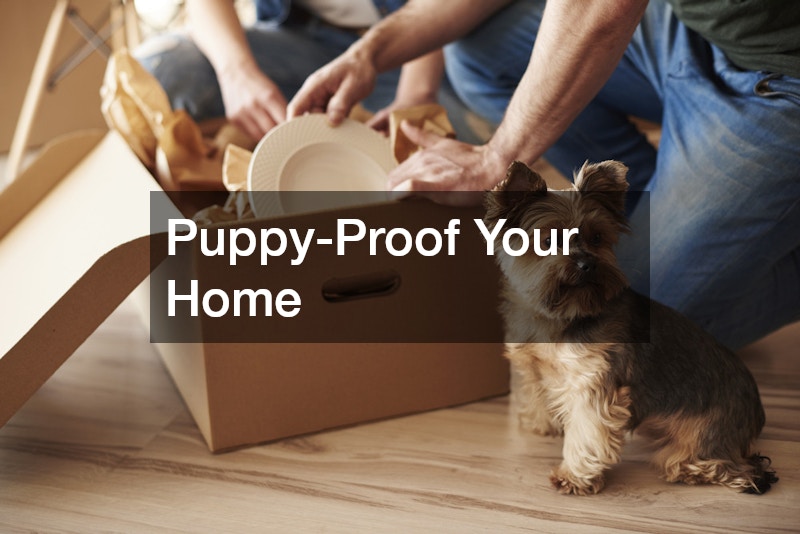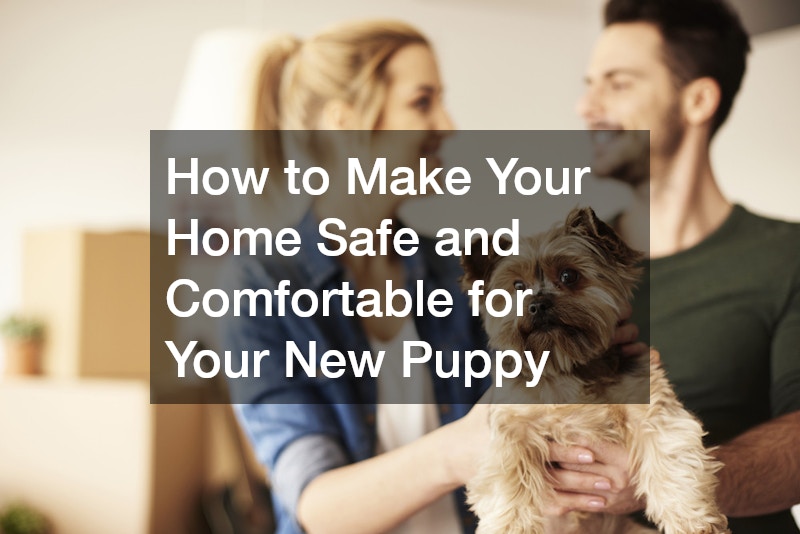Bringing home a new puppy is an exciting and joyous experience, but it also comes with a lot of responsibilities. Puppies are curious, energetic, and often mischievous as they explore their new surroundings. Ensuring your home is safe and comfortable is essential for a smooth transition and your puppy’s overall well-being. With proper preparation, including puppy-proofing your home and stocking up on essential pet care supplies, you can create a secure environment that allows your puppy to thrive.
Here’s how to make your home ready for your furry friend’s arrival.
1. Puppy-Proof Your Home

Puppies explore the world with their mouths and paws, so it’s important to remove potential hazards from their reach. Here are the steps to puppy-proof your home:
- Secure electrical cords: Puppies love to chew, and exposed cords can be a serious danger. Use cord protectors or hide cords behind furniture.
- Store chemicals and cleaners: Keep cleaning supplies, medications, and other toxic substances in cabinets with childproof locks.
- Remove small objects: Items like coins, buttons, or jewelry can easily be swallowed, posing a choking hazard. Keep these items out of reach.
- Protect trash cans: Secure trash cans with lids or store them behind closed doors to prevent your puppy from rummaging through them.
- Safeguard plants: Many common houseplants are toxic to dogs. Research your plants and remove any that could harm your puppy.
By viewing your home from a “puppy’s perspective,” you can identify potential dangers and ensure your puppy has a safe environment to explore.
Video Source
2. Create a Designated Space
Your puppy will feel more secure if they have a specific area to call their own. A designated space helps set boundaries and keeps your puppy safe when unsupervised. Consider the following:
- Use a crate: A crate provides a secure place for your puppy to rest and relax. It’s also a great tool for potty training and reducing anxiety.
- Set up a playpen: A puppy playpen gives your pup room to play and stretch without having full access to your home.
- Install baby gates: Use gates to block off areas where your puppy isn’t allowed, such as staircases or rooms with fragile items.
Having a safe, comfortable space helps your puppy adjust to their new home while giving you peace of mind.
3. Gather Essential Pet Care Supplies
Before your puppy arrives, stock up on pet care supplies to ensure you’re fully prepared. These items will make your life easier and help keep your puppy happy and healthy:
- Food and water bowls: Stainless steel bowls are durable, easy to clean, and resistant to chewing.
- Puppy food: Start with the food your puppy was eating at the breeder or shelter to avoid stomach upset. Transition to a new food gradually over two weeks if you plan to switch.
- Crate: Choose a crate that’s the right size for your puppy to stand, turn around, and lie down comfortably.
- Leashes and harnesses: Nylon leashes are practical and washable, while a harness is ideal for safe walks.
- Toys: Provide a mix of chew toys, interactive toys, and training toys to keep your puppy entertained and stimulated.
- ID tags: Include your contact information on your puppy’s collar to ensure their safety if they get lost.
Having these supplies ready makes your puppy’s first days at home easier and helps establish a routine.
4. Plan for Potty Training
Potty training is one of the most important aspects of welcoming a new puppy. To make the process smoother:
- Designate a potty spot: Take your puppy to the same outdoor area each time they need to go potty.
- Use positive reinforcement: Reward successful potty trips with praise or treats to encourage good behavior.
- Establish a schedule: Take your puppy outside frequently, especially after eating, playing, or waking up.
Patience and consistency are key to potty training success.
5. Introduce Your Puppy Gradually
The first day in a new home can be overwhelming for a puppy. Ease their transition by introducing them to their new environment and family members gradually:
- Meet the family: Encourage everyone to sit calmly and allow the puppy to approach them at their own pace. Teach children to interact gently and avoid loud noises or sudden movements.
- Introduce other pets: If you have other pets, supervise their interactions and allow them to get to know each other slowly.
A calm, controlled introduction helps your puppy feel safe and welcome.
6. Keep Your Puppy Engaged
Puppies have lots of energy and need mental and physical stimulation to prevent boredom. Toys play an important role in keeping them entertained and out of trouble:
- Chew toys: Satisfy your puppy’s urge to chew with safe, durable options like natural bones or rubber toys.
- Interactive toys: Puzzle toys that dispense kibble or treats are great for keeping your puppy occupied and engaged.
- Training toys: Use special toys like tug ropes or balls for interactive training sessions.
Rotate toys regularly to maintain your puppy’s interest and excitement.
7. Provide a Cozy Sleeping Area
Puppies need plenty of rest, especially during their first few months. Set up a comfortable sleeping area where your puppy can relax. A crate with soft bedding or old towels works well for young puppies. Covering the crate with a blanket can create a den-like environment that helps them feel secure.
Final Thoughts
Preparing your home for your new puppy involves careful planning and attention to detail. By puppy-proofing your space, gathering essential pet care supplies, and setting up a designated area, you can create a safe and comfortable environment that helps your puppy feel right at home. With patience, consistency, and love, you’ll set the foundation for a happy, well-adjusted companion who thrives in their new family.
.
